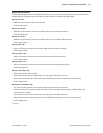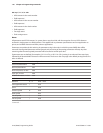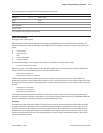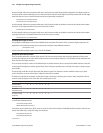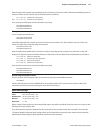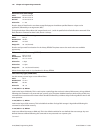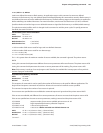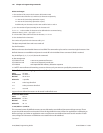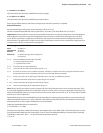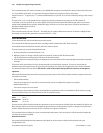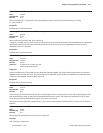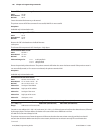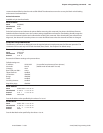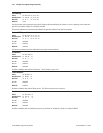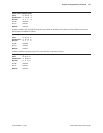
Chapter 5: Programming commands124
A776 (B780) Programming Guide A776-PG00001 C 12/09
Values and ranges:
s = the number of dot rows in the character cell (maximum 64)
c = the ASCII codes of the rst (c1) and last (c2) characters respectively
c1 = Hex 20–FF (20 is always printed as a space)
c2 = Hex 20–FF (20 is always printed as a space)
To dene only one character, use the same code for both c1 and c2
j = s/8 = the number of bytes (vertically) in the character cell
k = c2 – c1 + 1 = the number of characters to be dened in this command string
[character i data] = [ni d1 ... d(j x ni)] for 1 ≤ i ≤ k
ni = the number of dot columns for the ith character, 1 ≤ ni ≤ 16
d = the dot data for the characters
The number of bytes for the ith character cell is j x ni.
The bytes are printed down and across each cell.
See the illustration.
Denes and enters downloaded characters into RAM. The command may be used to overwrite single characters. User-
dened characters are available until power is turned o or the Initialize Printer command (1B 40) is received.
Any invalid byte (s, c1, c2, n1, n2) aborts the command.
er data storage area
1D 22 80 33 nL nH n sectors to permanent font area
1D 22 80 34 nL nH n sectors to electronic journal area
1D 22 80 40 end expanded ash memory allocation sequence
n = 0xFFFF means allocate all remaining sectors to this area; only one area can specify this parameter value.
Select ash area for storing logos and user-dened characters
ASCII GS” 0x81
Hexadecimal 1D 22 81 n
Decimal 29 34 129 n
Value of n: n species
n = 0 select logo/font ash
n = 1 select permanent font ash
n > 1 reserved
Logos and user-dened characters can be stored in either ash area.
Erase user ash sector
ASCII GS @ n
Hexadecimal 1D 40 n
Decimal 29 64 n
Value of n: 49 – 51
n = 49 (ASCII n = 1) HEX 31
This command erases all 64K ash memory sectors allocated to user-dened character and logos storage. Those
sectors should be erased in two situations: when the logo denition area is full and an application is attempting to
dene new logos, and when an application wants to replace one user-dened character set with another. In both
cases, all logos and character set denitions are erased and must be redened.
Continued . . .




